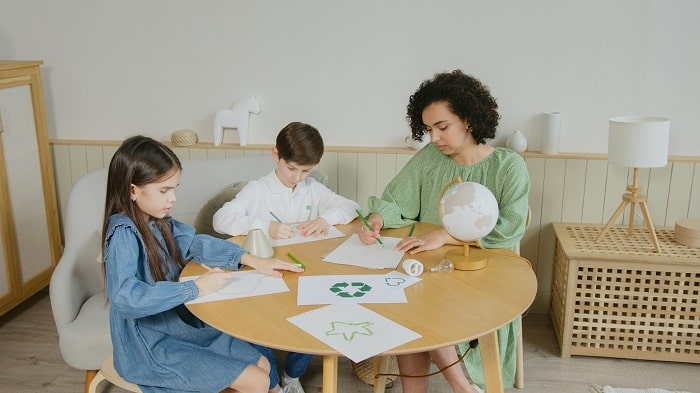Tired of the constant battles over turning off lights, separating recycling, or conserving water? It’s easy for sustainable living to become a source of frustration for both parents and kids. But what if these moments could be transformed into opportunities for growth and learning?
In this article, we’ll explore the concept of “From Whining to Winning” and provide practical strategies for turning tantrums about sustainability into teachable moments. By the end, you’ll have a toolkit of fun, imaginative ways to make eco-friendly practices enjoyable for your children. Let’s dive in and discover how to create lifelong eco-conscious habits together.
Kids love to test limits—especially when it comes to chores, routines, or anything that feels like an “adult” thing to do. Whether it’s a full-blown meltdown about turning off lights, a standoff over separating recycling, or a battle about conserving water, it’s easy for sustainable living to turn into a battleground. But what if I told you that these moments of resistance could be flipped on their head? What if every outburst became a chance to create lifelong eco-conscious habits?
Why Do Kids Resist Sustainability?
Before we jump into strategies, let’s break down *why* kids resist these changes in the first place. To be honest, it’s not that surprising. Kids live in a world where immediate satisfaction reigns supreme. Waiting an extra minute to turn off the faucet or taking a few extra steps to the recycling bin might seem like an enormous inconvenience to them. And let’s be real—who hasn’t had those days where it just feels easier to do it yourself?
But here’s the thing: sustainability isn’t just a “grown-up” responsibility. It’s a habit that, once instilled early, can last a lifetime. The key is figuring out how to transform those moments of frustration into opportunities for growth.
Turning Off Lights? Cue the “Saving Energy Dance!”
The Power of Movement and Fun
Every parent has experienced it—the lights are on in every room, your electricity bill is climbing, and you ask (for what feels like the hundredth time) for your child to turn off the lights when they leave the room. Cue the groans and eye rolls. Sound familiar?
Here’s a little secret: kids love to move. So instead of just asking them to flip the switch, why not turn it into a game? Enter the “Saving Energy Dance.” Every time they turn off a light, encourage them to do a little jig. Jump, spin, clap—whatever makes them giggle. Heck, join in yourself! Not only does this make the task fun, but it also creates a positive association with energy-saving behaviors.
Why It Works
By making the act of turning off lights an enjoyable experience, you’re tapping into the psychology of play. Kids learn best when they’re having fun, and when you gamify a task like this, it doesn’t feel like a chore anymore. It’s just one step towards winning! As an added bonus, it reinforces the idea that small actions have a big impact.
Recycling Showdown: Separating Fun from Frustration
A Playful Approach to Sorting
Let’s be honest—recycling can feel like a drag, especially when it involves sorting. But what if you transformed your kitchen into a mini-recycling plant? Give your child the title of “Recycling Supervisor” and make it their job to make sure everything ends up in the right bin. To spice it up, you could even time them, challenging them to see how quickly they can get it right.
Quick Tips for Success:
– Use color-coded bins or labels with fun images to help younger children.
– Reward them with eco-friendly treats when they hit milestones (think stickers or a small plant they can take care of).
When kids feel in control of a process, they’re more likely to participate without complaint. Plus, they’ll learn to recognize materials and the importance of reducing waste.
Water Conservation Wars: Making Bath Time Eco-Friendly
Transforming Bath Time into a Race
For many children, bath time is non-negotiable. It’s their chance to splash around, play with toys, and live in their little water wonderland. But with water conservation being more important than ever, it’s easy to feel conflicted.
Why not turn it into a game? Challenge your kids to see who can have the fastest, most efficient bath—without sacrificing cleanliness, of course! You could even use a timer, setting a fun goal like “Beat your best time!” to make it exciting.
Creating Water-Wise Champions
Explain to them that by conserving water, they’re superheroes for the planet. Reinforce the message by talking about water scarcity in simple terms: “Some places don’t have as much water, so we’re lucky to save ours!” Not only will this make bath time fun, but it will also instill a sense of responsibility.
Why Teachable Moments Matter
Shifting From “Whining” to Learning
The beauty of transforming tantrums into teachable moments lies in the fact that kids are *always* learning, whether we realize it or not. If we frame sustainability as something that’s fun, engaging, and part of everyday life, kids will adopt it naturally. Remember, they mirror our behaviors, so when we show enthusiasm for eco-friendly practices, it’s contagious!
Small Wins Lead to Big Changes
Imagine this: by turning off a few more lights, conserving a little extra water, and making sure their recycling is on point, your child is contributing to a larger movement. These small actions add up to real-world impact. And as they grow, these sustainable habits will be second nature.
FAQs About Sustainable Living for Kids
1. What age is best for teaching sustainability?
Start as young as possible! Even toddlers can get involved in simple tasks like turning off lights or sorting recyclables with visual aids. The earlier you start, the more ingrained these habits become.
2. How do I handle it if my child just refuses?
Take a breath—it’s normal! Kids often resist when they feel forced. Try to reframe the task in a fun way, or break it down into smaller steps. If they’re really pushing back, give them choices within limits: “Would you like to do the recycling first or turn off the lights?”
3. Can I use rewards or incentives?
Absolutely! Small, eco-friendly incentives can work wonders. Consider using non-material rewards like extra playtime, choosing a family movie, or earning an extra bedtime story.
Sustainable Living for Kids: Final Thoughts on Turning Tantrums Into Teachable Moments
Teaching kids about sustainability doesn’t have to be a fight. By turning daily chores into teachable moments through play, creativity, and understanding, you’ll set them up for a lifetime of eco-friendly habits. Remember, it’s not about perfection—it’s about progress. And when you approach sustainability with joy and patience, you’re already winning.
What fun ideas do you have to transform those “whiny” moments into teachable ones? Share your thoughts in the comments below! Let’s create a community where we help each other raise eco-conscious kids.
Have a great tip or a funny story about your child’s sustainability tantrum? Drop it in the comments! We’d love to hear how you’re turning your own little tantrums into winning moments!

